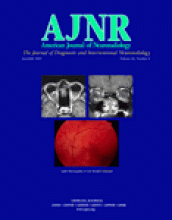Abstract
BACKGROUND AND PURPOSE: Differentiation between tumor recurrence and treatment-related brain injury is often difficult with conventional MRI. We hypothesized that the diffusion-weighted imaging (DWI) could help differentiate these 2 conditions, because water diffusion may be greater for necrotic tissues in the treatment-related brain injury than for tumor tissues in recurrence. Our aim was to analyze whether DWI findings of recurrent tumor are distinct from those of radiation necrosis.
METHODS: Seventeen patients were examined prospectively. Two readers assessed the images by consensus for homogeneity and signal intensity of the lesions. Five regions of interest were drawn within the lesions on trace DWI images and apparent diffusion coefficient (ADC) maps. The minimal, maximal, and mean values of each lesion were compared between the 2 groups. Findings in 12 of 17 patients were verified histologically by surgery or biopsy; the diagnoses in the remaining 5 patients were made on the basis of follow-up MRI findings and clinical follow-up.
RESULTS: There were a total of 20 lesions; 12 lesions were due to radiation necrosis and 8 lesions to tumor recurrence. In the radiation necrosis group, 8 lesions had marked hypointensity. In the recurrence group, however, no marked hypointensity was seen. The maximal ADC values within each lesion were significantly smaller for the recurrence group than for the necrosis group (P = .039).
CONCLUSION: Radiation necrosis usually showed heterogeneity on DWI images and often included spotty, marked hypointensity. Significant difference was found in the maximal ADC values between radiation necrosis and tumor recurrence. DWI was useful in differentiating recurrent neoplasm from radiation necrosis.
- Copyright © American Society of Neuroradiology












